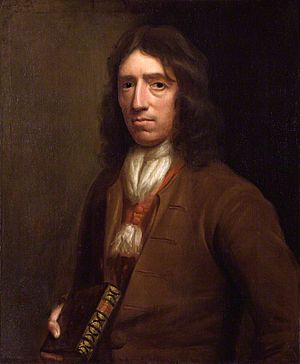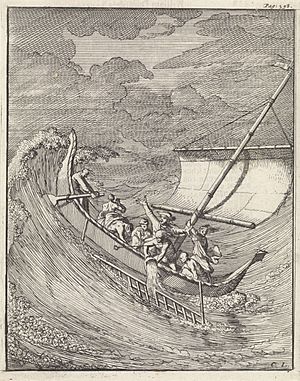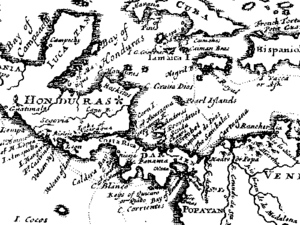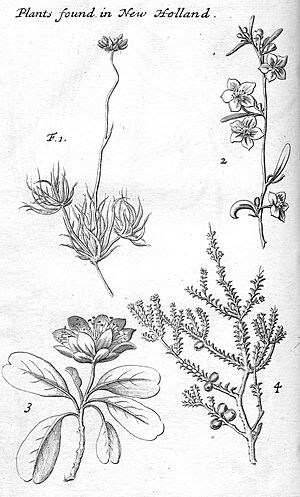William Dampier facts for kids
Quick facts for kids
William Dampier
|
|
|---|---|

Portrait of Dampier holding his book, a painting by Thomas Murray (c. 1697–1698)
|
|
| Born | baptised 5 September 1651 East Coker, Somerset, England
|
| Died | March 1715 (aged 63) London, England
|
| Nationality | English and, after the Union, British |
| Occupation | Privateer and explorer |
| Known for | Exploring and mapping Australia, Circumnavigation |
| Spouse(s) | Judith Dampier |
William Dampier (born 1651, died 1715) was a famous English explorer, pirate, and navigator. He was the first Englishman to explore parts of Australia. He was also the first person to sail around the world three times!
Dampier is seen as an important explorer between Francis Drake and James Cook. He combined the adventurous spirit of Drake with the scientific curiosity of Cook. His trips helped Europeans learn about new plants, animals, and foods. He was one of the first English writers to use words like avocado, barbecue, and chopsticks. He also described how to make guacamole and named the breadfruit plant.
After writing a popular book called A New Voyage Round the World, Dampier was given command of a Royal Navy ship. He made important discoveries in western Australia. Later, he rescued Alexander Selkirk, a sailor who might have inspired the book Robinson Crusoe. Other famous people like James Cook and Charles Darwin were influenced by Dampier's work.
Contents
William Dampier's Early Life
William Dampier was born in East Coker, Somerset, England, in 1651. He was baptized on September 5th. He went to King's School, Bruton. Dampier started sailing early. He went on two merchant trips to Newfoundland and Java. In 1673, he joined the Royal Navy. He even fought in two battles that year.
Dampier became very sick, so he returned to England. He spent several months getting better. For a few years, he tried different jobs. He worked on plantations in Jamaica and logged trees in Mexico. Eventually, he joined another sailing trip. He married Judith around 1679. But he left for the sea again just a few months later.
Dampier's First Trip Around the World
In 1679, Dampier joined a group of buccaneers (pirates) led by Captain Bartholomew Sharp. They were sailing in Central America. This trip led to his first journey around the world. He crossed the Isthmus of Darién in Panama. He also helped capture Spanish ships in the Pacific Ocean. The pirates then raided Spanish towns in Peru.
Dampier later went to Virginia. In 1683, he joined another privateer, John Cooke. They sailed around Cape Horn into the Pacific. For a year, they raided Spanish areas in Peru, the Galápagos Islands, and Mexico. This group grew, sometimes having ten ships. After Cooke died, Edward Davis became the new captain.
Dampier then moved to Charles Swan's ship, the Cygnet. On March 31, 1686, they sailed across the Pacific. They planned to raid the East Indies. They stopped at Guam and Mindanao in the Philippines. The Spanish people there saw them as pirates and even cannibals. Dampier and some others left Swan in Mindanao. They sailed to Manila, Vietnam, China, the Spice Islands, and New Holland (Australia).
On January 5, 1688, the Cygnet anchored off the northwest coast of Australia. This was near King Sound. Dampier stayed there until March 12th. While the ship was being repaired, Dampier wrote notes. He described the plants, animals, and local people he found. Later that year, Dampier and two shipmates were left on one of the Nicobar Islands. They found a small canoe and sailed to Aceh in Sumatra.
Dampier returned to England in 1691. He had no money, but he had his journals. These journals would later become very famous.
The Roebuck Expedition
Dampier's book, A New Voyage Round the World, became very popular in 1697. The Admiralty (the British Navy's leaders) were impressed. In 1699, King William III gave Dampier command of a warship. It was called HMS Roebuck and had 26 guns. His mission was to explore the east coast of New Holland (Australia).
The expedition started on January 14, 1699. They sailed to New Holland by going around the Cape of Good Hope. On August 6, 1699, Dampier sailed into what he called Shark Bay in Western Australia. He landed and began to record the plants and animals. These were the first detailed records of Australian wildlife. His clerk, James Brand, is thought to have drawn the plants. Dampier then sailed north-east along the coast. He reached the Dampier Archipelago and Lagrange Bay. He kept recording and collecting samples, including many shells. From there, he sailed north to Timor.
On December 3, 1699, he sailed around New Guinea. He mapped the south-eastern coasts of New Hanover, New Ireland, and New Britain. He also charted the Dampier Strait between these islands and New Guinea. Along the way, he collected more samples, like giant clams.

By this time, the Roebuck was in very bad shape. Dampier had to give up his plan to explore Australia's east coast. The ship was in danger of sinking. He tried to sail back to England, but the ship sank near Ascension Island on February 21, 1701. The crew was stranded there for five weeks. Luckily, another ship picked them up on April 3rd. They returned home in August 1701.
Many papers were lost when the Roebuck sank. But Dampier saved some new maps of coastlines. He also kept his records of trade winds and currents around Australia and New Guinea. He also saved a few plant samples. These samples were given to the Fielding-Druce Herbarium at the University of Oxford. In 2001, the wreck of the Roebuck was found near Ascension Island. Dampier's story of this trip was published as A Voyage to New Holland in 1703.
When Dampier returned from the Roebuck expedition, he faced a court-martial. This is a military trial. His lieutenant, George Fisher, had complained about how Dampier treated him. Dampier defended himself, but he was found guilty. He lost some of his pay and was removed from the Royal Navy. The court decided he was not fit to command any of the King's ships.
Dampier's Second Trip Around the World
The War of the Spanish Succession began in 1701. English privateers were getting ready to fight French and Spanish ships. Dampier was made commander of the ship St George. It had 26 guns and 120 men. Another ship, the Cinque Ports, joined them. They sailed from Ireland on September 11, 1703. The two ships had a rough journey around Cape Horn. They arrived at the Juan Fernández Islands in February 1704. There, they fought a French merchant ship but couldn't capture it.
Dampier managed to capture some small Spanish ships. But he released them after taking only a small part of their goods. He wanted to focus on bigger plans. He planned to raid Santa María, a town in Panama. It was rumored to have lots of gold. But when his men attacked, they met strong resistance. Dampier had to pull back. In May 1704, the Cinque Ports separated from the St George. Its crew left Alexander Selkirk alone on an island. The Cinque Ports later sank off Colombia. Some of its crew survived but were captured by the Spanish.
The St George was left to try and capture the Manila galleon. This was the main goal of the trip. They saw the galleon on December 6, 1704. It was caught off guard. But while Dampier and his officers argued, the galleon loaded its guns. The St George was outmatched by the galleon's bigger guns. It suffered serious damage and had to stop the attack.
Failing to capture the galleon broke up the expedition. Dampier and about thirty men stayed on the St George. The rest of the crew took a captured ship across the Pacific. The damaged St George had to be left on the coast of Peru. Dampier and his remaining men took a Spanish prize ship to the East Indies. There, the Dutch threw them in prison as pirates. They were later released. Without a ship, Dampier made his way back to England in late 1707.
Dampier's Third Trip Around the World and Death
In 1708, Dampier joined another privateer ship called the Duke. This time, he was not the captain but the pilot. The Duke sailed into the South Pacific with another ship, the Duchess. This trip was more successful. They rescued Selkirk on February 2, 1709. The expedition gathered a lot of valuable goods. Most of this came from capturing a Spanish galleon in December 1709.
In January 1710, Dampier crossed the Pacific in the Duke. They stopped at Guam before arriving in Batavia. After repairs and selling one of their captured ships, they sailed to the Cape of Good Hope. They waited there for over three months for other ships to join them. They left with 25 Dutch and English ships. Dampier was now serving as the sailing master of the captured galleon. After another delay, they arrived in London on October 14, 1711.
Dampier may not have lived to receive all his share of the trip's profits. He died in London. The exact date and details of his death are not known. His will was approved on March 23, 1715. So, it is thought he died earlier that month.
Dampier's Legacy
William Dampier influenced many people, even if they are more famous than him:
- He greatly improved navigation. He collected important information on currents, winds, and tides. This data was used by explorers like James Cook and Joseph Banks.
- Jonathan Swift mentioned Dampier in his book Gulliver's Travels. He compared Dampier to his main character, Lemuel Gulliver.
- His notes on Australian plants and animals were studied by Joseph Banks. This helped lead to the naming of Botany Bay and the start of modern Australia.
- His scientific observations helped Alexander von Humboldt and Charles Darwin develop their theories.
- He is mentioned over 80 times in the Oxford English Dictionary. This is for words like "barbecue", "avocado", and "chopsticks". He didn't invent these words, but his writings are the first known English examples of them.
- He recorded the first English recipes for guacamole and mango chutney.
Places Named After William Dampier
Many places and things are named after William Dampier:
- Dampier, a town and port in Western Australia.
- Dampier Archipelago, Western Australia.
- Dampier County, a land division in New South Wales.
- Dampier Island, now called Burrup Peninsula, in Western Australia.
- Dampier Peninsula, Western Australia.
- Dampier Ridge, part of the submerged continent of Zealandia.
- Mount Dampier, a high peak in New Zealand.
- Dampier Strait (Indonesia) and Dampier Strait (Papua New Guinea).
- The Division of Dampier, an old voting area in Australia.
- The minor planet 14876 Dampier.
- A British survey ship, HMS Dampier.
- Postage stamps from Australia Post in 1966 and 1985.
- The Australian flowering plant genus Dampiera.
Books by William Dampier
Here are some of the books William Dampier wrote:
- A New Voyage Round the World (1697)
- Voyages and Descriptions (1699)
- A Voyage to New Holland (1703)
- A Supplement of the Voyage Round the World (1705)
- The Campeachy Voyages (1705)
- A Discourse of Winds (1705)
- A Continuation of a Voyage to New Holland (1709)
See also
 In Spanish: William Dampier para niños
In Spanish: William Dampier para niños



